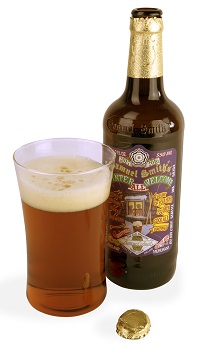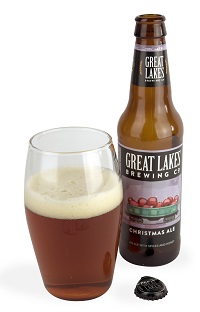Winter Warmer and Holiday Ale
Brewed to match the rich, sweet and fragrant cuisine of the holidays, winter warmers and spiced holiday ales are stout enough to warm the soul and savory enough to abide the hearty fare. After the tease of autumnal Märzen and pumpkin beer, we have come to anticipate these specialties greatly. Winter warmers are typically loaded with luscious, dessertlike malty character, while holiday ales are similar, with an aromatic perk of added spices. They evoke the British tradition of offering strong ale to conquer the wintry chill and celebrate holiday festivities.
Winter Warmer
In centuries past, brewers were beholden to the vagaries of climate, harvest and manpower, as brewing was always seasonal by nature. Stronger beers, naturally more stable and sustaining, were made for and kept until cooler months. Today’s winter warmers, modern conveniences aside, are no less tailored to the season. They are modeled on strong English ales that include old ale, barley wine, Yorkshire Stingo and Burton ale, all closely related, nearly interchangeable brews of the 18th and 19th centuries.
Burton ale is noteworthy in this legacy, with a rather direct lineage from historical versions of winter warmer to those we recognize today. Originally crafted at Burton-on-Trent (later the epicenter of IPA) for export to Baltic aristocrats in the 18th century, Burton ale was well-aged, sweet, somewhat hoppy, relatively pale (given the color of its contemporaries) and, of course, strong. It also became favored as a winter warmer back home. Old ale and Burton ale would become essentially synonymous terms.
Draft Burton ale was a common cask offering in Britain until just after World War II, but by the 1950s and ’60s, it met an inexplicable, precipitous fall. Ballantine’s Burton Ale, aged up to 20 years in oak before bottling, was brewed in the U.S. during the same period. It met a similar fate.
One of the few vestiges after the demise was Young’s Burton Ale, whose name was changed to Winter Warmer in 1971, aimed at rebranding the floundering style as a distinct seasonal. Samuel Smith’s Winter Welcome was introduced to the U.S. in 1990. These imports helped provide some impetus to American microbrewers to explore new stylistic seasonal brews and in some small measure helped reinvigorate an endangered family of beers.
Winter warmers, from either side of the pond, still favor the old ale/Burton ale pedigree. They feature 5.5 to 8% ABV, bitter/sweet balance, chewy, nutty dark malt, dried fruit notes and often sugar adjuncts, such as honey or brown sugar. Odell Isolation Ale and Boulevard Nutcracker Ale are some of the best examples brewed in the U.S.
English winter warmers well worth seeking include St. Peter’s Winter Ale (rich and creamy, with notes of dates and toffee); Fuller’s 1845 (authentic Burton ale, bottle-conditioned, fruity, relatively hoppy and earthy), Theakston’s Old Peculier (dark, vinous and treacly old ale) and Samuel Smith’s Yorkshire Stingo (bottle-conditioned, aged for a full year in oak barrels before release, with notes of vanilla, brown sugar and raisin).
Holiday Ale
Another perennial winter favorite is spiced holiday ale. Just as pumpkin beers begin to fade, along come these savory, robust, aromatic ales to pick up the slack. Holiday ales may have also been influenced by British ancestry, those ales of yore spruced up to celebrate the Solstice, Christmas, New Year’s and Twelfth Night.
Old British winter customs included serving warm ale that had been variously spiked with spirits, eggs, sugar and whatever spices or botanicals were available or preferred. One such beverage was known as wassail, named for the medieval English salutation wæs hæil, a toast of good health and fortune.
Wassail was served from a communal bowl and was quite an impressive concoction, with ale as the main ingredient. Wassail could also be mulled wine or cider, while “wassailing” refers to the Twelfth Night offering of thanks and respect to the orchards for a successful harvest, both past and future.
Modern spiced holiday ales, though, have a more recent inspiration, invoking the spirit of wassail, and fueled by the innovations of the modern American brewing Renaissance.
Fritz Maytag of Anchor Brewing Co. counts among his many groundbreaking American microbrews the famous, and eminently influential, Anchor Christmas Ale, introduced in 1975.
The Anchor Christmas Ale recipe changes from year to year and is first and foremost a malt-forward spiced ale. The label annually features a different honorary tree, the quintessential symbol of winter festivity. Christmas Ale brims with holiday ambience and can be cellared for years.
Anchor Christmas Ale stood alone for a while, but American brewers began padding their portfolios with unique winter seasonal offerings in the 1980s and ’90s, building on Maytag’s seminal, ingenious brew. There are now dozens to look forward to each year.
Holiday ales are generally graced with many of the same spices and flavorings that we encounter in the season’s cuisine, especially desserts. Nutmeg, cinnamon, vanilla, orange peel and anise are frequent additions. Highland Brewing’s Cold Mountain Winter Ale, Anderson Valley Winter Solstice and Full Sail Wassail are three that capture the essence of the holiday spirit.

Samuel Smith's Winter Welcome Ale
ABV: 6%Tasting Notes: This North Yorkshire brewery has been operating since 1758, serving up traditional, retro and innovative brews. Winter Welcome is as straightforward as strong ale gets, gaining complexity and finesse from premium, traditional ingredients, a unique house yeast and Yorkshire Square slate fermenters. It pours dark amber, with a stiff, creamy ivory head. The nose is malty with some caramel and wisps of stone fruit, plus floral, woodsy hop aromatics. Smooth and medium-bodied, it has caramel/honey sweetness, but mostly a firm malt framework with hoppy flavors of herbs and lemon. The finish is wonderfully appetizing. Simple and elegant. There may be no more versatile beer for the holidays.

Deschutes Jubelale
ABV: 7.5%Tasting Notes: Jubelale sits firmly in the winter warmer category, blending a broad palette of American and English ingredients in stellar fashion. The deep chestnut-brown color and billowing beige head impress. A big hop aroma with citrus and spruce is followed by toasted malt, caramel, vanilla and toffee. Full-bodied, the flavor brings chocolate, caramel, brown sugar sweetness and figs, with a rather firm dose of woodsy, herbal and fruity hops. The finish is silky with a bit of roasted dryness. Simply put, one of the best winter warmers anywhere and a mutual celebration of two great brewing nations.

Great Lakes Christmas Ale
ABV: 7.5%Tasting Notes: Great Lakes has really come into its own in the past decade as one of the finest, most versatile breweries in the U.S. Great Lakes Christmas Ale is spiced, laced with honey and combining pale, wheat, crystal and roasted malts for a near-perfect holiday ale. The head is deep copper in color, stiff and tenacious. Quite fragrant, with cinnamon and ginger sifting through a floral-sweet aroma. Well-rounded, mellow, clean and complex. Hops take a back seat to the spice, honey and sweet maltiness—reminiscent of gingerbread or spice cake. Some pear/peach fruitiness is subtly laced throughout as well, with a bit of warmth in the finish.
K. Florian Klemp
K. Florian Klemp is an award-winning homebrewer who thinks there is no more sublime marriage than that of art and science.

Great article. I esp. like the historical perspectives.
I agree with the comment regarding the historical references. As a NE Ohio resident I’m very familiar with Great Lakes & recommend this year’s offering. Another(locally brewed)seasonal to try if you can get it is Thirsty Dog’s 12 Dogs of Christmas, which I felt topped GL’s Christmas Ale last year.
Thanks for a great article, this is helped connect the dots for a British ex-pat living in Oregon.